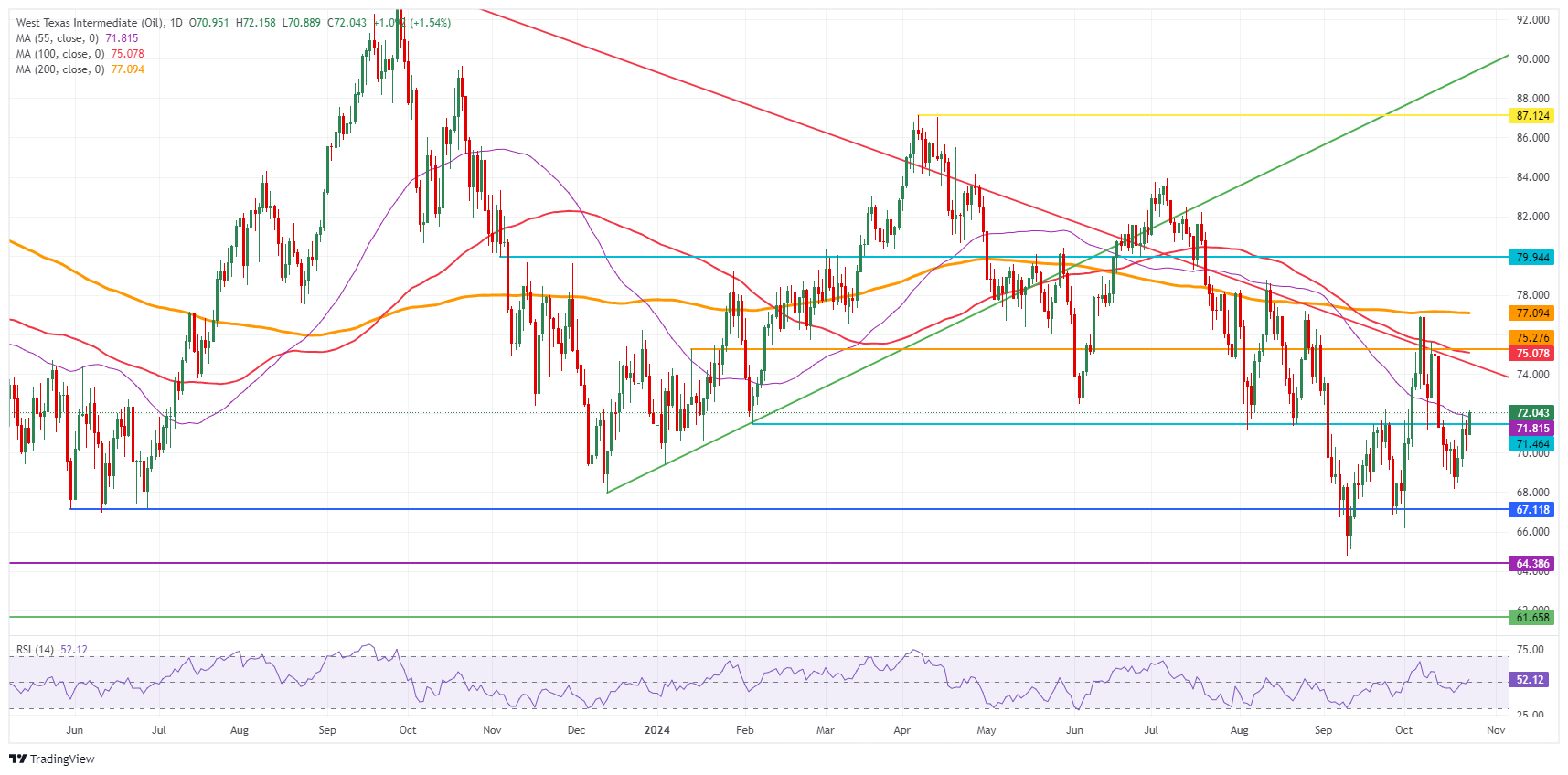- Crude Oil extends weekly gains, moving away from $70.00 and looking for further upside.
- Markets are pricing in rising geopolitical tensions following US Secretary of State Blinken’s failed attempts in the Middle East.
- The US Dollar Index fades after its strong rally earlier this week, with the focus on the US PMI on Thursday.
Crude oil prices continue to rise and extend weekly gains on Thursday, with traders once again focusing on the geopolitical side of the price action. The revaluation comes after US Secretary of State Antony Blinken failed to negotiate a diplomatic agreement between Israel and Iran and even failed to convince Israel to allow humanitarian aid in the region. Markets are writing off his visit and attempts as a failure, opening room for further escalations in the region.
The US Dollar Index (DXY), which tracks the performance of the dollar against six other currencies, fades on Thursday ahead of the preliminary reading of the US Purchasing Managers’ Index (PMI) for October. The DXY rally was steep this week, with several key levels being breached on its way above 104.00. With less than 14 days until the US presidential election on November 5, the US dollar is expected to remain under pressure, primed for further gains.
At the time of writing, Crude Oil (WTI) is trading at $72.10 and Brent Crude at $76.00
News on Oil and the markets: Saudi Arabia is losing
- Saudi Arabia sees its oil export revenues fall to the lowest level in more than three years. The main reason is the slow growth in demand, which weighs on crude oil prices, according to Bloomberg.
- ExxonMobil has sold its onshore oil and gas assets in Nigeria to Seplat Plc for around $1.3 billion following approval from the Nigerian government, Reuters reports.
- Mexico’s state oil company Pemex has increased its oil and gas reserves during President Claudia Sheinbaum’s term, several official documents showed, Reuters reports.
Oil Technical Analysis: It Gets Complicated
The price of crude oil is rising and recovering further on Thursday, gaining ground and returning to $75.00. The move comes after markets were too focused on the US presidential election and briefly forgot about the Middle East geopolitical card. Antony Blinken’s uneventful visit has brought traders’ attention back to the region, making clear that tensions are far from over and can only escalate further.
At the time of writing, crude oil price has risen above the 55-day SMA at $71.81, and needs to preferably see a daily close above this level to confirm a breakout. Next, the important technical level at $75.08, with the 100-day SMA and some key lines, is possibly the first major hurdle ahead.
On the downside, traders should look much lower at $67.12, a level that supported the price in May and June 2023. Should that level be broken, the 2024 year-to-date low emerges at 64.75 $, followed by $64.38, the 2023 low.
US WTI Crude Oil: Daily Chart
WTI Oil FAQs
WTI oil is a type of crude oil that is sold in international markets. WTI stands for West Texas Intermediate, one of the three main types that include Brent and Dubai crude. WTI is also known as “light” and “sweet” for its relatively low gravity and sulfur content, respectively. It is considered a high-quality oil that is easily refined. It is sourced in the United States and distributed through the Cushing facility, considered “the pipeline junction of the world.” It is a benchmark for the oil market and the price of WTI is frequently quoted in the media.
Like all assets, supply and demand are the main factors that determine the price of WTI oil. As such, global growth can be a driver of increased demand and vice versa in the case of weak global growth. Political instability, wars and sanctions can alter supply and impact prices. The decisions of OPEC, a group of large oil-producing countries, is another key price factor. The value of the US Dollar influences the price of WTI crude oil, as oil is primarily traded in US dollars, so a weaker Dollar can make oil more affordable and vice versa.
Weekly oil inventory reports published by the American Petroleum Institute (API) and the Energy Information Agency (EIA) influence the price of WTI oil. Changes in inventories reflect the fluctuation of supply and demand. If the data shows a decline in inventories, it may indicate an increase in demand, which would drive up the price of oil. An increase in inventories can reflect an increase in supply, which drives down prices. The API report is published every Tuesday and the EIA report the next day. Their results are usually similar, with a difference of 1% between them 75% of the time. EIA data is considered more reliable since it is a government agency.
OPEC (Organization of the Petroleum Exporting Countries) is a group of 13 oil-producing nations that collectively decide member countries’ production quotas at biannual meetings. Their decisions often influence WTI oil prices. When OPEC decides to reduce quotas, it can restrict supply and drive up oil prices. When OPEC increases production, the opposite effect occurs. OPEC+ is an expanded group that includes ten other non-OPEC member countries, including Russia.
Source: Fx Street
I am Joshua Winder, a senior-level journalist and editor at World Stock Market. I specialize in covering news related to the stock market and economic trends. With more than 8 years of experience in this field, I have become an expert in financial reporting.








